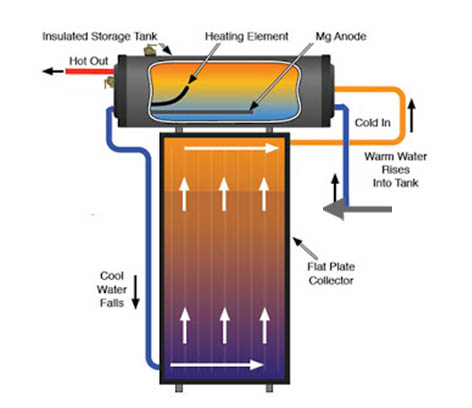Solar Water Heating System
Solar water heaters also called solar domestic hot water systems - can be a cost-effective way to generate hot water for your home. They can be used in any climate, and the fuel they use -- sunshine -- is free.
How they work
A solar thermal system works by harnessing the sun’s energy and converting it into heat which is then transferred into your home or businesses heating system as hot water or space heating. The solar collector will use the sun’s rays to heat the water or transfer fluid which is a mixture of water and glycol, to prevent the water from freezing in the winter. These collectors are then connected to an insulated tank that stores the hot water. This heated water can be used for bathing or other industrial applications. There are two types of solar water heating systems: active, which have circulating pumps and controls, and passive, which works on thermosiphon principle.

Passive Solar Water Heating Systems
Passive solar water heating systems are typically less expensive than active systems, but they're usually not as efficient. However, passive systems can be more reliable and may last longer. There are two basic types of passive systems:
- Integral collector-storage passive systemsThese work best in areas where temperatures rarely fall below freezing. They also work well in households with significant daytime and evening hot-water needs (Small domestic systems).
- Thermosyphon systemsWater flows through the system when warm water rises as cooler water sinks. The collector must be installed below the storage tank so that warm water will rise into the tank.

Active Solar Water Heating Systems
There are two types of active solar water heating systems:
- Direct circulation systemsPumps circulate household water through the collectors and into the home. They work well in climates where it rarely freezes.
- Indirect circulation systemsPumps circulate a non-freezing, heat-transfer fluid through the collectors and a heat exchanger. This heats the water that then flows into the home. They are popular in climates prone to freezing temperatures.

Types of Collectors:
Flat Plate Collector
The flat-plate solar collectors are probably the most fundamental and most studied technology for solar-powered domestic hot water systems. The overall idea behind this technology is pretty simple. The Sun heats a dark flat surface, which collect as much energy as possible, and then the energy is transferred to water, air, or other fluid for further use.
These are the main components of a typical flat-plate solar collector:
- These are the main components of a typical flat-plate solar collector:
- Glazing cover - a transparent layer that transmits radiation to the absorber, but prevents radiative and convective heat loss from the surface
- Copper Tubes containing heating fluid to transfer the heat from the collector
- Support structure to protect the components and hold them in place
- Insulation covering sides and bottom of the collector to reduce heat losses

Evacuated-tube solar collectors
An evacuated-tube collector consists of parallel rows of glass tubes connected to a header pipe. Each tube has the air removed from it to eliminate heat loss through convection and radiation.

Solar On Grid System
Solar PV modules are semiconductor devices which generate electricity when exposed to sun light. In a SPV module a large number of such photovoltaic cells are connected in series. The electrons flow from one cell to next through a conductor. In the next cell they are further struck by photons and acquire more potential energy and sweep out of the cell and so on. Finally, the electron leaves the last cell of the module and flow through the load. It is sunlight or irradiance, not heat, which produces electricity in photovoltaic cells.
Solar panels, also known as solar modules, are generally connected together in ‘strings’ to create a what is known as a solar array. The amount of solar energy generated depends on several factors including the orientation and tilt angle of the solar panels, efficiency of the solar panel, plus any losses due to shading, dirt and even ambient temperature.

HYBRID Solar PV System
Solar PV modules are semiconductor devices which generate electricity when exposed to sun light. In a SPV module a large number of such cells are connected in series. The electrons flow from one cell to next through a conductor. In the next cell they are further struck by photons and acquire more potential energy and sweep out of the cell and so on. Finally, the electron leaves the last cell of the module and flow through the load. Crystalline and Thin Film are most widely used technologies. Solar panels, also known as solar modules, are generally connected together in ‘strings’ to create a what is known as a solar array. The amount of solar energy generated depends on several factors including the orientation and tilt angle of the solar panels, efficiency of the solar panel, plus any losses due to shading, dirt and even ambient temperature. The Solar Power Generating System consists of Solar Photovoltaic Modules to generate DC Electricity. DC Electricity generated can be stored in Battery for later usage or can be used directly for consumption through Inverter or simultaneously both can be done. Power consumption priorities can be set as per customer requirements. The inverter would convert the DC power into AC power. This AC power is fed to the load and used for captive purpose only.



